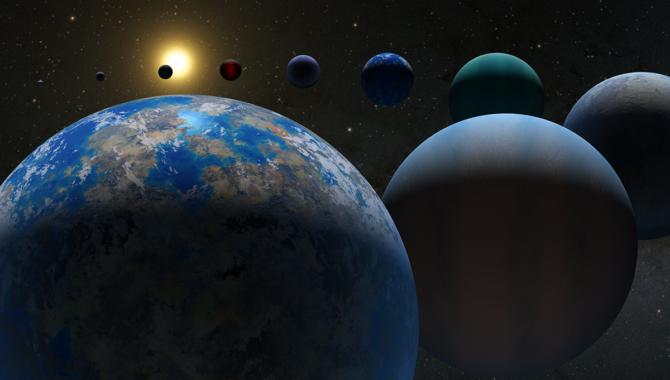
More than 5,000 exoplanets have been identified, representing only a small fraction of total number and displaying the great diversity in the universe.
Illustration Credit: Artist’s illustration/NASA/JPL-Caltech
Technology builds understanding of Crater constellation.
About 90 light years from Earth, in a cup-shaped constellation known as Crater, glows an M-Type star labelled LP 791-18. In the past five years astronomers have identified this small star—substantially redder and cooler than our Sun, and a mere fraction of its diameter—as one of the coolest to host orbiting planets.
Human interest in this area of the night sky is not new. Greco-Roman astronomer Ptolemy included Crater in a list of 48 constellations nearly 2,000 years ago. In mythology, the 9 stars that form the Crater constellation are the drinking cup of Apollo, thrown into the sky in a fit of anger provoked by a deceitful bird and a snake—the constellations Corvus and Hydra—that are clustered nearby.
The scientific reality that has emerged in the past three decades with the use of precision technology is equally fascinating. When the European Space Agency’s Hipparcos satellite scanned that region of the sky in the early 1990s, it revealed more than 570 stars, 38 of which can be seen with the unaided eye under the right conditions.
NASA launched the Transiting Exoplanet Survey Satellite (TESS) in 2018 to survey for evidence of exoplanets. Over a 2-year primary mission, TESS divided the sky into 26 sectors and surveyed each segment for about four weeks. Exoplanets manifest as a regular pattern of brief reductions in the observed brightness of a star. This can indicate an orbiting body is passing before it. In March of 2019, TESS surveyed the region.
Later that year, a team of astronomers led by Ian J. M. Crossfield, an Assistant Professor of Physics and Astronomy at Kansas University’s Department of Physics and Astronomy, used TESS data to identify two exoplanets orbiting LP 791-18. LP 791-18b is slightly larger in diameter than Earth and orbits the star in less than a day. LP 791-18c is more than 2.3 times Earth’s diameter, with more than 7 times the mass, and orbits the star in about five days.
“Because the host star is small the decrease in light during these planets’ transits is fairly large (0.4% and 1.7%),” the team noted in a paper announcing their discovery. “This has allowed us to detect both planets’ transits from ground-based photometry, refining their radii and orbital ephemerides.”
Now, a different team of astronomers, led by Merrin Peterson, a graduate of the Trottier Institute for Research on Exoplanets (iREx) based at the University of Montreal, has identified a third planet orbiting LP 791-18, using data from TESS and NASA’s Spitzer Space Telescope, which was launched in 2003 on a 2.5 year primary mission that eventually stretched to 5.5 years before entering a new phase that extended to January of 2020.
The newly identified planet, LP 791-18d, is slightly larger than Earth, and orbits the star in less than three days. It appears to be a dichotomous world, “tidally locked,” with one side facing the star continuously and reaching blistering temperatures, while the other faces permanently into space. It orbits on the edge of what is known as the “habitable zone,” a band in which the distance from the star could accommodate the presence of liquid water.

LP 791-18d, shown here in an artist’s concept, is an Earth-size world about 90 light-years away. The gravitational tug from a more massive planet in the system, shown as a blue disk in the background, may result in internal heating and volcanic eruptions – as much as Jupiter’s moon Io, the most geologically active body in the solar system. Astronomers discovered and studied the planet using data from NASA’s Spitzer Space Telescope and TESS (Transiting Exoplanet Survey Satellite) along with many other observatories.
Illustration Credits: NASA’s Goddard Space Flight Center/Chris Smith (KRBwyle)
“The day side would probably be too hot for liquid water to exist on the surface. But the amount of volcanic activity we suspect occurs all over the planet could sustain an atmosphere, which may allow water to condense on the night side,” said Björn Benneke, a co-author and astronomy professor at iREx who planned and supervised the study, in a NASA press release.
The data indicates that LP 791-18d passes very close to the much larger LP 791-18c during its orbit. The team believes that the larger planet’s strong gravitational force briefly deforms the smaller planet during each encounter and pulls it into a somewhat elliptical orbit, begging comparisons to Jupiter’s moon, Io.
Io is pulled powerfully in different directions by the gravity of Jupiter and its moons Europa and Ganymede. Io is the most volcanically active body in our solar system, home to a subsurface ocean of magma estimated to be 31 miles thick and reaching temperatures beyond 2,000 degrees Fahrenheit. Some of Io’s volcanoes have ejected lava more than 20 miles into the sky, with plumes extending up another 160 miles.
“A big question in astrobiology, the field that broadly studies the origins of life on Earth and beyond, is if tectonic or volcanic activity is necessary for life,” said co-author Jessie Christiansen, a research scientist at NASA’s Exoplanet Science Institute at the California Institute of Technology in Pasadena, in the NASA press release. “In addition to potentially providing an atmosphere, these processes could churn up materials that would otherwise sink down and get trapped in the crust, including those we think are important for life, like carbon.”
Scientific knowledge of the LP 791-18 system will soon grow. Even before LP 791-18d was identified, time had been allotted to examine LP 791-18c using the James Webb Space Telescope, which has the capability to distinguish if an exoplanet has an atmosphere and identify elements within that atmosphere, such as water, sulfur dioxide, carbon monoxide, sodium, and potassium.










